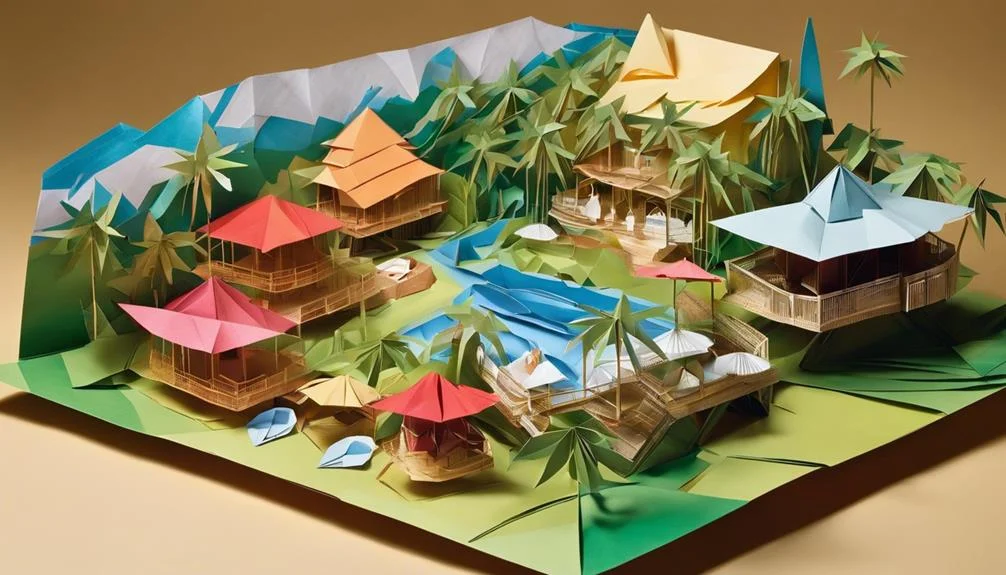The discourse surrounding the impact of tourism in Hawaii presents a multifaceted analysis, encompassing both its undeniable contributions to economic prosperity and its potential pitfalls. As the industry flourishes, creating job opportunities and promoting cultural exchange, it simultaneously grapples with the challenges of environmental sustainability, the preservation of cultural heritage, and the well-being of local communities.
This dichotomy prompts a deeper examination of how Hawaii can navigate the complexities of tourism to foster an equitable balance between economic growth and the stewardship of its unique natural and cultural resources. The ensuing discussion invites a thoughtful exploration into achieving this equilibrium.
Key Takeaways
- Tourism significantly boosts Hawaii’s economy, contributing around 20% to its GDP.
- Natural attractions draw visitors, but tourism poses threats to marine ecosystems and coral reefs.
- Cultural exchange enriches experiences, yet commercialization harms traditional Hawaiian practices.
- Overcrowding and high living costs impact locals, highlighting the need for sustainable tourism practices.
Economic Boon
Tourism stands as Hawaii’s most significant economic driver, contributing approximately 20% to the state’s total economy and underscoring its crucial role in sustaining local livelihoods and revenue streams. The industry’s immense contribution is not merely a statistic; it reflects the vibrant interaction between Hawaii’s natural beauty and cultural heritage with global visitors. In 2019 alone, visitor spending reached an impressive $17.75 billion, illustrating the financial boon tourism brings to the islands. This expenditure supports approximately 216,000 jobs, highlighting tourism’s pivotal role in employment and community welfare.
The annual influx of nearly $20 billion into Hawaii’s economy from tourism underscores the sector’s indispensability in generating revenue. This financial injection is vital for the state’s infrastructure development, healthcare, education, and other essential services, benefiting residents and visitors alike. However, the reliance on tourism also exposes the state to vulnerabilities, particularly evident when slow growth in tourism leads to job cuts in businesses. This scenario reveals the fine balance Hawaii must manage between leveraging tourism for economic benefit and ensuring resilience against fluctuations in global travel trends.
Natural Wonders

Hawaii’s landscape, a tapestry of majestic volcanoes, enchanting waterfalls, and lush rainforests, positions the state as a premier destination for those seeking to explore natural wonders. The islands are home to iconic formations such as Kilauea and Mauna Loa, volcanoes that offer visitors a glimpse into the powerful geological processes that shape our planet. Kauai, often referred to as the ‘Garden Isle,’ exemplifies the state’s stunning beauty with its diverse landscapes ranging from verdant rainforests to dramatic cliffs.
The allure of Hawaii extends beyond its terrestrial marvels to include world-renowned beaches like Waikiki and Lanikai. These sandy retreats offer more than just sunbathing opportunities; they are gateways to exploring vibrant coral reefs and crystal-clear waters teeming with a rich marine ecosystem. The active lava flows of Kilauea and the lush foliage of the Na Pali Coast further underscore the islands’ unique appeal, providing unforgettable experiences for nature enthusiasts.
Cultural Exchange

Cultural exchange in Hawaii offers a nuanced aspect of tourism by fostering an environment where visitors and native Hawaiians can share and learn from each other’s traditions and values. This interaction not only enhances tourists’ understanding of Hawaiian culture but also poses challenges, including the potential disruption of traditional practices.
The balance between promoting cultural appreciation and preserving indigenous customs is a critical point of consideration in assessing the impacts of tourism on the island’s cultural heritage.
Enhancing Local Understanding
Engaging in cultural activities, such as hula dancing and lei making, not only enriches the visitor experience but also plays a crucial role in the preservation and celebration of Hawaiian traditions. These interactions foster a mutual understanding and appreciation between tourists and local communities, enhancing the visitors’ connection to Hawaii’s rich cultural heritage.
Learning about traditional practices, like taro farming and ukulele playing, tourists gain insights into the values, beliefs, and customs of native Hawaiians. Supporting local initiatives and businesses focused on preserving Hawaiian culture not only creates meaningful interactions but also promotes cultural exchange. This approach to tourism ensures that cultural learning is not a one-way street but a shared journey that benefits both visitors and locals alike.
Traditional Practices Disruption
The commercialization of tourism has led to the disruption of traditional Hawaiian practices, compromising the authenticity of cultural exchanges between locals and visitors. This disruption not only affects the portrayal of Hawaiian culture but also its preservation and transmission to future generations.
- Cultural Misrepresentation: Tourist-focused attractions often simplify or alter traditional practices, like hula dancing and lei-making, stripping them of their true cultural significance and turning them into mere entertainment.
- Exploitation of Traditions: The pursuit of profit has led to the commodification of native Hawaiian cultural exchanges, exploiting them for tourist consumption rather than respecting their intrinsic value.
- Distortion of Significance: Commercialized luaus and cultural performances can mislead visitors about the authentic meanings and traditions behind these practices, undermining the integrity of Hawaii’s cultural heritage.
Environmental Impact

The environmental impact of tourism in Hawaii raises significant concerns. Particularly, issues include marine life disruption, habitat degradation, and waste management challenges.
The influx of tourists contributes to the disturbance of marine ecosystems and the destruction of natural habitats, essential for the survival of native species. Additionally, the inability to effectively manage waste produced by tourism activities exacerbates the threat to Hawaii’s environment, necessitating urgent attention and action.
Marine Life Disruption
Tourism in Hawaii has significantly disrupted marine life, leading to negative impacts on native wildlife and ecosystems. The allure of Hawaii’s pristine waters and diverse marine inhabitants has attracted millions of visitors annually, but at a cost that is increasingly becoming apparent.
- Pollution Challenges: The influx of tourists contributes to pollution, from waste to harmful sunscreen ingredients, threatening the health of marine ecosystems.
- Disruption from Marine Tours: Activities like feeding and harassing fish during marine tours change the natural behavior of marine species, undermining the ecological balance.
- Coral Reef Degradation: Stress on coral reefs from tourism-related activities is causing significant damage, affecting not only the coral’s health but also the biodiversity it supports, leading to a diminishing marine life habitat.
These factors collectively underscore the urgent need for sustainable tourism practices to mitigate the adverse effects on Hawaii’s marine life.
Habitat Degradation
Amid Hawaii’s natural beauty, habitat degradation emerges as a pressing concern, driven largely by the environmental impact of tourism. The allure of the islands has led to significant deforestation and land development, threatening Hawaii’s unique ecosystems.
Construction of tourist infrastructure, including resorts and hotels, has resulted in considerable habitat loss, especially in high traffic areas, severely impacting native wildlife populations. Moreover, pollution from tourism activities, such as improper waste disposal and runoff, poses a significant threat to marine life and ecosystems, further exacerbating the situation.
This degradation has led to a decline in fish populations, vital for native Hawaiians, highlighting the direct consequences of tourism-related activities like overfishing and habitat destruction on the islands’ delicate ecosystems and endemic species.
Waste Management Challenges
Annually, Hawaii faces the daunting challenge of managing over 3 million tons of solid waste, a considerable portion of which results from the island’s bustling tourism sector. This issue not only strains the existing waste management infrastructure but also poses significant environmental threats.
- Inadequate Infrastructure: Many tourist hotspots lack the necessary facilities to handle the increased waste, leading to pollution and harm to marine ecosystems.
- Plastic Pollution: The improper disposal of plastics by tourists exacerbates the degradation of Hawaii’s pristine coastal environments, threatening the survival of marine species.
- Landfill Overload: The surge in tourism-related waste, particularly single-use plastics and excessive packaging, intensifies the pressure on landfill capacities and recycling efforts, underscoring the urgent need for sustainable waste management solutions in the face of growing tourist numbers.
Overcrowding Issues

Facing the challenge of millions of visitors each year, Hawaii grapples with significant overcrowding issues that detract from the quality of the tourist experience. The allure of its pristine beaches, lush trails, and vibrant culture draws a vast number of tourists, leading to crowded beaches, congested trails, and long queues, especially during peak seasons. This not only impacts the visitor experience by offering less secluded and authentic encounters with nature and local culture but also places a considerable strain on accommodations, dining options, and local resources.
The surge of tourists during peak times exacerbates the problem, making it hard for visitors to fully enjoy Hawaii’s natural beauty and for residents to go about their daily lives without disruption. The high volume of tourists underscores the urgent need for sustainable tourism practices. Implementing measures that manage the flow of visitors can help preserve Hawaii’s natural beauty and cultural heritage, ensuring that both tourists and residents can enjoy the islands sustainably. Addressing overcrowding is crucial in maintaining the allure of Hawaii as a premier tourist destination while safeguarding its environmental integrity and cultural richness for future generations.
Cost of Living

How does tourism, celebrated for its economic contributions, paradoxically fuel the high cost of living in Hawaii? The allure of Hawaii’s pristine beaches and vibrant culture draws millions of tourists annually, significantly impacting the local economy. However, this influx of visitors has a darker side, particularly when it comes to the cost of living for Hawaii’s residents. The tourism industry, while a boon in terms of employment and economic activity, also contributes to making Hawaii one of the most expensive states to live in the United States.
- Housing Market Pressures: The demand for accommodations and properties by tourists and investors drives up housing prices, placing a considerable burden on local residents. Many find it increasingly difficult to afford homes in their own communities.
- High Cost of Imported Goods: With Hawaii’s reliance on imported goods, prices are substantially higher than on the mainland. This affects everything from groceries to gasoline, further straining the budgets of local families.
- Lower-Paying Tourism Jobs: Despite the plethora of jobs generated by the tourism sector, many of these positions offer relatively low wages. This disparity makes it challenging for workers in the tourism industry to cope with the high cost of living, despite being a critical part of the economy driving these costs.
Preserving Tradition

In Hawaii, the rapid development of tourism infrastructure poses a significant threat to the preservation of native Hawaiian traditions and cultural heritage. Native Hawaiians find themselves in a constant struggle to maintain their traditional practices amidst the ever-growing sprawl of hotels, resorts, and other tourist-oriented facilities. The expansion often results in the destruction of vital aspects of their culture, including traditional taro lands and sacred burial sites, which are bulldozed to make way for new developments.
Resort developments not only encroach upon these culturally significant sites but also pressure the native population to suppress aspects of their traditional lifestyle to conform to what is often a commercialized version of their culture tailored for tourist consumption. This commodification extends to cultural sites that are exploited to attract tourists, with little regard for the profound impact on the indigenous population. The commercialization of Hawaiian culture not only distorts its authenticity but also threatens its very survival, as native Hawaiians are forced to navigate the fine line between preserving their heritage and adapting to the demands of a booming tourism sector.
Conclusion
In conclusion, tourism in Hawaii offers a multifaceted impact, intertwining economic benefits with cultural exposure while simultaneously presenting challenges such as environmental degradation, overcrowding, and an elevated cost of living for local inhabitants.
The sustainability of Hawaii’s tourism sector hinges on implementing strategies that balance economic growth with environmental stewardship and cultural preservation.
Ensuring that the islands remain vibrant and inviting for future visitors requires a concerted effort from all stakeholders to address these challenges comprehensively.